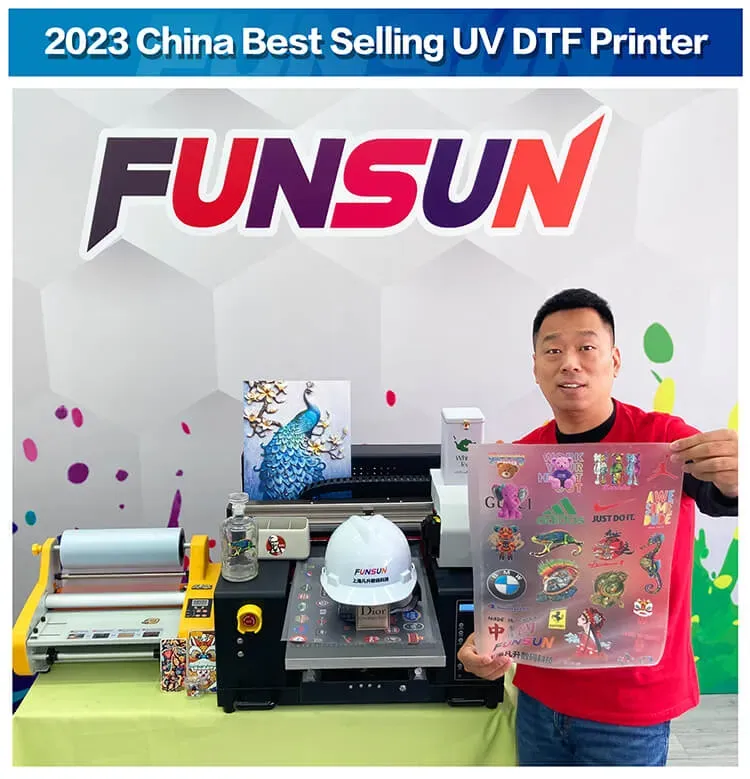UV DTF printing represents a transformative leap in digital printing solutions, merging the precision of digital techniques with the vibrancy of UV-cured inks. This innovative printing technology allows for exceptionally detailed graphics to be printed on transfer films, which can then be applied to a wide variety of substrates, from textiles to rigid surfaces. Unlike traditional printing methods such as screen printing and offset printing, UV DTF offers remarkable speed and adaptability, making it an ideal choice for businesses that require quick turnaround times without compromising on quality. In this article, we will delve into how UV DTF printing outperforms its counterparts by delivering durable multi-surface prints that maintain their brilliance over time. Understanding the nuances of UV DTF compared to traditional methods is essential for anyone looking to make informed decisions in a rapidly evolving printing landscape.
Direct to Film (DTF) printing has evolved into a powerful contender against conventional printing processes, such as screen printing and lithography. This modern method utilizes ultraviolet-cured inks that solidify quickly, resulting in vibrant, high-quality images that can be transferred onto various materials. As the demand for versatile digital printing technologies surges, DTF has emerged as a popular choice for businesses seeking efficient and dynamic printing solutions. By leveraging cutting-edge printing technology, companies can achieve exceptional results that were once only possible with more traditional techniques. This introduction aims to highlight the advantages of UV DTF printing, emphasizing its role in shaping the future of the printing industry.
Understanding the Basics of UV DTF Printing
UV DTF printing is an innovative technology streamlining the printing process by utilizing a unique method where UV-cured inks are applied directly to a transfer film. This film is subsequently placed onto a desired substrate, allowing for extensive versatility in materials. Because it uses UV light to cure the inks, the process is incredibly quick, rendering sharp, vibrant designs suitable for a variety of applications—ranging from textiles to durable surfaces.
One of the remarkable features of UV DTF printing is how it accommodates complex designs and colorful graphics with excellent detailing, which can be a challenge in traditional printing methods. The fast curing of inks not only enhances productivity and minimizes idle time during production but also provides a solution for businesses needing rapid turnarounds on custom orders. Thus, UV DTF printing is fast becoming the go-to method for those who require quality printing solutions in time-sensitive contexts.
The Efficiency of UV DTF Compared to Traditional Printing
When evaluating the efficiency of UV DTF printing against traditional methods, it’s crucial to highlight the significant differences in production speed. UV DTF printing eliminates many of the lengthy processes inherent to traditional screen printing, significantly reducing the time between design conception and product delivery. This improved efficiency caters to modern business needs where agility and responsiveness are essential, helping companies maintain customer satisfaction.
In contrast, traditional printing methods such as screen printing can be labor-intensive and time-consuming, involving extensive manual setup for detailed designs. This often leads to longer production times and can be a barrier for companies aiming for quick responses to market changes. Thus, UV DTF printing not only enhances production speed but also ensures businesses can meet the rapidly evolving demands of today’s consumer landscape.
Using cutting-edge printing technology like UV DTF allows businesses to pivot much quicker than relying solely on traditional techniques, ensuring they remain competitive.
Durability of UV DTF Printing: A Comparison
Durability is a vital aspect when choosing a printing method, particularly for products that will endure outdoor conditions. UV DTF printing shines in this arena, thanks to its UV-cured inks, which are exceptionally resistant to fading and peeling. This makes it invaluable for businesses seeking to produce high-quality promotional materials or apparel that must withstand harsh environmental factors over time.
While traditional printing methods, especially those reliant on liquid inks, can provide impressive visuals, they often do not capture the same level of durability that UV DTF offers. Traditional methods require more delicate handling and might necessitate extra protective measures to maintain appearance over extended periods of use. For those prioritizing longevity in their printed products, UV DTF stands out as a far superior choice.
Cost Analysis of UV DTF Printing vs Traditional Techniques
When examining the cost implications, many may find UV DTF printing presents an attractive financial model despite its higher initial investment. The long-term savings derived from lower ink consumption and less waste can significantly enhance profitability for businesses over time. This technology minimizes operational costs while maximizing output quality, making it a wise investment for those looking to stay ahead in the competitive printing market.
On the other hand, traditional printing methods may initially appear more economical, especially for large production jobs. However, the hidden costs associated with setup times and inefficiencies for smaller runs can lead to inflated overall expenses. Businesses needing flexibility in print quantities may find the true costs of traditional methods outweigh the apparent savings, further solidifying the argument for transitioning to UV DTF technologies.
Versatility: Applications of UV DTF Printing
UV DTF printing showcases remarkable versatility, allowing it to cater to diverse industries ranging from fashion to promotional goods. It enables printing on a wide array of materials, both porous and non-porous, extending a business’s ability to create customized products tailored to specific customer demands. Whether it’s about creating exquisite visuals on fabric or producing robust signage, UV DTF technology facilitates exceptional quality across different platforms.
Furthermore, the adaptability of UV DTF means that smaller businesses can leverage its capabilities to explore various market niches without investing extensively in multiple traditional printing devices. This opens opportunities for customization which is increasingly being sought after in contemporary markets where consumers value unique, personalized products, enhancing customer satisfaction and brand loyalty.
The Future of Printing: Embracing Digital Solutions
The transition towards digital printing solutions, with UV DTF leading the charge, redefines the printing landscape. As customers increasingly demand personalization and quick turnaround times, the need for traditional methods diminishes. UV DTF not only meets these requirements but also provides an avenue for innovation in printing, allowing manufacturers to explore a multitude of creative avenues.
Recent advancements within UV DTF technology emphasize improvements aimed at sustainability and performance, suggesting that the future of printing will heavily lean towards eco-friendly and efficient practices. As manufacturers prioritize these initiatives, UV DTF is positioned to dominate the sector, catering to environmentally conscious businesses while still maintaining product quality and production efficiency.
Frequently Asked Questions
What are the benefits of UV DTF printing compared to traditional printing methods?
UV DTF printing offers several benefits over traditional printing methods, including faster production times, vibrant colors due to UV-cured inks, and the ability to print on a wider range of substrates. Additionally, the durability of prints made with UV DTF exceeds that of many traditional methods, making it ideal for outdoor applications.
How does UV DTF printing technology work?
UV DTF printing technology works by printing UV-cured inks onto a transfer film. Once printed, the film is applied to various surfaces, where the UV lights cure the inks, ensuring they harden quickly. This process enables intricate designs and excellent color vibrancy, distinguishing UV DTF from traditional printing techniques.
Can UV DTF printing be used on different materials?
Yes, UV DTF printing is highly versatile and can be used on various materials, including fabrics, metals, plastics, and glass. This adaptability makes it a popular choice among businesses looking to create customized promotional materials and products, unlike traditional methods that may be limited to specific substrates.
What are the cost implications of using UV DTF printing vs. traditional printing methods?
While the initial investment in UV DTF printing equipment may be higher, this method can lead to long-term savings due to lower ink consumption and reduced waste. In contrast, traditional printing methods may seem cost-effective for large runs but can become expensive due to high setup costs for smaller jobs.
Is UV DTF printing more environmentally friendly than traditional printing methods?
UV DTF printing is generally considered more environmentally friendly than many traditional printing methods, primarily due to its use of UV-cured inks that emit fewer VOCs (volatile organic compounds). Additionally, the reduced waste and lower energy consumption during the printing process contribute to its sustainability.
What industries can benefit from UV DTF printing?
UV DTF printing can benefit a wide range of industries, including fashion, promotional products, signage, and packaging. Its ability to produce high-quality prints on both porous and non-porous materials makes it suitable for creative applications across various sectors, providing a modern solution that traditional methods may not meet.
| Key Points | UV DTF Printing | Traditional Printing Methods |
|---|---|---|
| Overview of Technology | Uses UV-cured inks on transfer film; versatile application on different substrates. | Includes screen printing and offset printing; relies on liquid inks and requires multiple steps for color setups. |
| Quality and Durability | Offers vibrant colors, sharp details, durable for outdoor and long-lasting applications. | Good color accuracy but may not withstand harsh conditions as effectively. |
| Speed and Efficiency | Significantly reduced lead times; ideal for just-in-time manufacturing. | Setup is time-consuming, limiting adaptability for small production runs. |
| Cost Implications | Higher initial investment but lower operational costs lead to long-term savings. | Can appear cost-effective for large runs but has hidden costs for smaller jobs. |
| Applications | Versatile across industries; suitable for both porous and non-porous materials. | Effective in textiles but may not meet modern diverse market demands. |
| Current Trends | Digital solutions like UV DTF are rising due to demand for customization and quick production. | Traditional methods are still relevant but face challenges in versatility. |
Summary
UV DTF Printing has emerged as a groundbreaking technology in the print industry, revitalizing how products are designed and produced. This state-of-the-art printing method offers numerous advantages, such as superior durability, vibrant colors, and rapid production speeds, making it a compelling choice for modern businesses seeking high-quality prints across various substrates. As companies increasingly demand customization and efficiency, UV DTF Printing stands out as the preferred solution over traditional printing methods, which often struggle to meet current market needs. Furthermore, the ongoing innovations in UV DTF technology reflect a commitment to sustainability and efficiency, positioning it as a dominant force in the future of printing.



